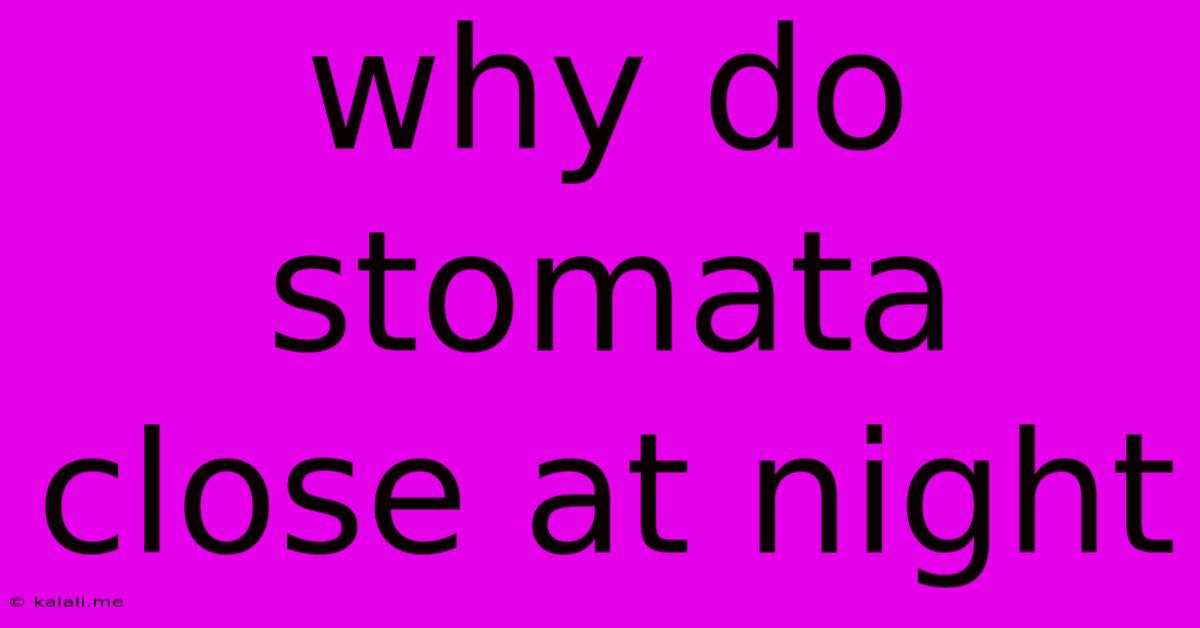Why Do Stomata Close At Night
Kalali
May 21, 2025 · 3 min read

Table of Contents
Why Do Stomata Close at Night? A Deep Dive into Plant Physiology
Meta Description: Discover the crucial role of stomata in plant respiration and photosynthesis, and why these tiny pores close at night, conserving water and optimizing gas exchange. Learn about the complex interplay of factors influencing stomatal closure.
Plants, the silent architects of our ecosystem, possess an ingenious mechanism for survival and growth: stomata. These microscopic pores on leaf surfaces regulate gas exchange, allowing for the intake of carbon dioxide (CO2) for photosynthesis and the release of oxygen (O2) and water vapor. But why do these vital pores close at night? The answer lies in a complex interplay of physiological processes designed to optimize the plant's survival and efficiency.
The Crucial Role of Stomata in Photosynthesis and Respiration
During the day, stomata remain open to facilitate photosynthesis. This process requires CO2, which enters the leaf through the open stomata. Simultaneously, oxygen, a byproduct of photosynthesis, is released. However, this opening also leads to significant water loss through transpiration – the evaporation of water from the plant's leaves. This is a constant balancing act for the plant: maximizing CO2 uptake for photosynthesis while minimizing water loss.
At night, photosynthesis ceases because sunlight, the energy source for this process, is unavailable. Consequently, the demand for CO2 diminishes drastically. This is where the closure of stomata becomes crucial.
The Primary Reason: Water Conservation
The most significant reason for stomatal closure at night is water conservation. With photosynthesis inactive, there's no need for CO2 uptake. Keeping the stomata open at night would lead to unnecessary water loss through transpiration, potentially dehydrating the plant. This is particularly important in arid or semi-arid environments where water is scarce.
Secondary Factors Influencing Stomatal Closure
While water conservation is the primary driver, other factors contribute to stomatal closure at night:
-
Reduced Light Intensity: The absence of light signals a decrease in photosynthetic activity, triggering a cascade of physiological events leading to stomatal closure. This involves changes in the turgor pressure within guard cells – the specialized cells surrounding the stomata – causing them to close.
-
Decreased CO2 Concentration: Although photosynthesis is inactive, respiration continues at night. However, the rate of respiration is significantly lower than photosynthesis during the day, resulting in a decrease in the internal CO2 concentration. This lower CO2 concentration contributes to stomatal closure.
-
Changes in Hormone Levels: Plant hormones, such as abscisic acid (ABA), play a role in regulating stomatal opening and closing. ABA levels typically increase at night, promoting stomatal closure and conserving water.
-
Temperature Fluctuations: Temperature changes can also affect stomatal behaviour. Cooler night-time temperatures can indirectly contribute to stomatal closure, although the effect is often less pronounced than light and water availability.
The Complex Interplay of Factors
It's important to understand that stomatal closure at night is not a single event triggered by a single factor. It's a result of the integrated response of the plant to various environmental and physiological cues, ensuring optimal water use efficiency and survival.
In conclusion, the closure of stomata at night is a vital adaptive mechanism for plants, primarily driven by the need to conserve water when photosynthesis is inactive. This intricate process highlights the remarkable efficiency and adaptability of plant physiology in responding to environmental challenges. Understanding these mechanisms is crucial for improving crop yields and managing water resources in agriculture, especially in the face of climate change.
Latest Posts
Latest Posts
-
Can You Park On A Solid White Line
May 21, 2025
-
Why Am I Not Getting Taxed
May 21, 2025
-
Why Did Shae Sleep With Tywin
May 21, 2025
-
Best Team For X And Y
May 21, 2025
-
Can You Drink The Tap Water In France
May 21, 2025
Related Post
Thank you for visiting our website which covers about Why Do Stomata Close At Night . We hope the information provided has been useful to you. Feel free to contact us if you have any questions or need further assistance. See you next time and don't miss to bookmark.